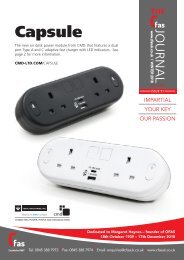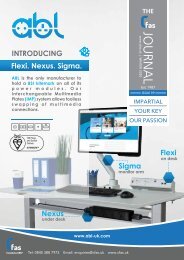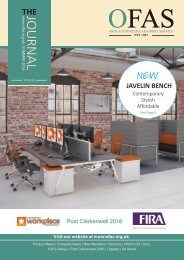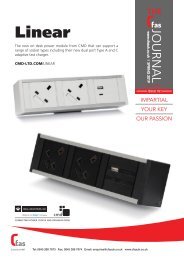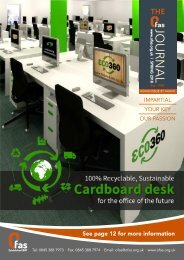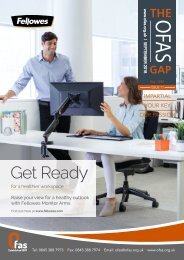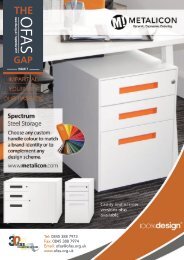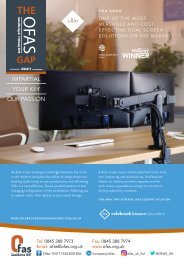Spring 2017
Spring 2017
Spring 2017
You also want an ePaper? Increase the reach of your titles
YUMPU automatically turns print PDFs into web optimized ePapers that Google loves.
Editorial<br />
Moving the<br />
Workforce Towards<br />
Sit-stand Solutions<br />
Editorial kindly provided by FIRA<br />
Since the launch of the ‘Get Britain<br />
Standing’ campaign two years ago, it<br />
seems that health benefits of standing<br />
up whilst working is being recognised<br />
by both employers and employees.<br />
People are now more likely to accept<br />
that sitting for extended periods<br />
without moving, may increase the<br />
risk of the onset of cardio vascular<br />
diseases, obesity, diabetes and general<br />
unfitness.<br />
Rapid technology advances, changing<br />
the way we work, is also pushing<br />
people into ever more sedentary life<br />
styles. Long hours, often in seated<br />
postures can not only affect our health<br />
and general well-being, but also our<br />
productivity and efficiency in the<br />
workplace.<br />
This does not mean, however, that we<br />
should switch from prolonged sitting<br />
to prolonged standing. Neither is good<br />
– the human body is not designed<br />
for static postures. Movement is the<br />
key for maintaining a healthy body,<br />
hence alternating between sitting<br />
and standing is the answer. There<br />
are no exact defined time periods of<br />
sitting versus standing. It depends<br />
on the individual and what they are<br />
doing; however as general rule 10<br />
to 15 minutes of standing for every<br />
hour or so of being seated seems to be<br />
beneficial.<br />
Levent Çaglar, Chief Ergonomist<br />
at FIRA, has been warning about<br />
the dangers of prolonged sitting at<br />
workplaces, as well as highlighting<br />
how rapid changes in technology<br />
have pushed people to more sedentary<br />
lifestyles in schools, offices and at<br />
home. Over the past few years he has<br />
been advocating the use of standing<br />
work surfaces in offices and schools<br />
and has been at the forefront of getting<br />
people to alternate between sitting<br />
and standing while they work.<br />
The furniture industry has been<br />
responding by providing new and<br />
innovative sit/stand solutions. These<br />
desks are very popular in Scandinavia,<br />
where it’s been estimated by Get<br />
Britain Standing that over 90% of<br />
office workers enjoy the health and<br />
engagement benefits of being able<br />
to easily switch between sitting and<br />
standing.<br />
Over recent years, as the desks have<br />
grown in popularity, the price point<br />
for a more basic desk has dropped.<br />
There are now many affordable sit/<br />
stand desks, not only electrically<br />
operated, but also operated by various<br />
mechanical mechanisms, even gas<br />
assisted fast crank mechanisms.<br />
It is not just furniture manufacturers<br />
who are finding innovative solutions<br />
to the sit/stand issue. Retro-fit<br />
desk top sit/stand solutions such<br />
as combined keyboard/monitor<br />
arms are now available that fit on a<br />
standard, fixed height, desk, allowing<br />
the user to move easily from sitting<br />
to standing. With such accessories,<br />
it is now possible to transform<br />
existing fixed height desks into sit/<br />
stand workstations very quickly and<br />
economically.<br />
Levent continued: “Standing all day<br />
is not a viable or doable solution as<br />
people get tired. The best solution is to<br />
switch between sitting and standing<br />
by using sit-stand desks or have<br />
alternative work surfaces available.<br />
The option is a must for anyone who<br />
already has back problems, but more<br />
importantly, if you want to prevent<br />
an increased risk of developing back<br />
pain for your staff through prolonged<br />
sitting at workplaces, you should at<br />
least consider providing sit-stand<br />
desks at your next refurbishment or<br />
office relocation.”<br />
For advice on how to achieve good<br />
sit-stand solutions and ergonomics<br />
advice to improve your work<br />
environments and efficiency of your<br />
staff, contact Levent Çaglar, FIRA, on<br />
01438 777 700, or by emailing lcaglar@<br />
fira.co.uk. Find out more about FIRA<br />
Ergonomics visit www.fira.co.uk/<br />
ergonomics.<br />
24 www.ofas.org.uk SPRING <strong>2017</strong>





